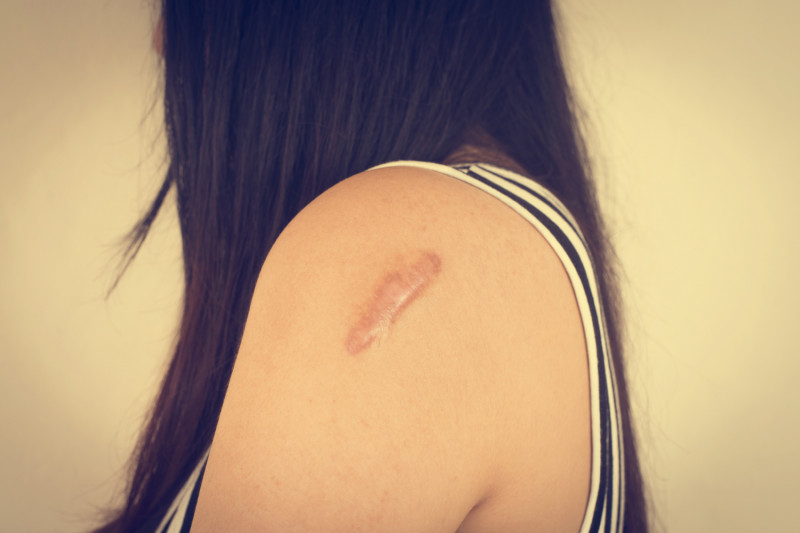
When the tissues are damaged, scars occur as a part of the body's natural healing process. The condition may be caused by the damaged tissue, traumatic injuries, surgical procedures, animal bite, burns, acne or rash that may impair the integrity of the skin.
Scar revision is an intervention to improve the appearance of scars. Non-surgical methods (laser, dermapen, various injections etc.) may be applied or surgery alone or surgery in combination with additional methods may be performed. All incisions made intentionally during surgeries, lacerations and wounds heal by leaving scar. The look/size of a scar depends on many factors like the wound type, the location of the wound, methods applied to repair the wound and the skin type. During scar revision, the appearance of the wound can be improved or it can be moved to another area to minimize its visibility.
A wound scar may require up to 2 years to become stable. This period of time is necessary for the body’s natural healing methods. The body produces many collagens to heal the wound. As it generates new blood vessels, the wound appears dark, reddish. Less blood is supplied to the wound scar in time and thus it starts to become flat. Before any treatment, the wound should be left untouched and it is necessary to evaluate its final status. Experienced doctors make decision on treatment time after examination.
Scar revision can tremendously improve the patient’s appearance, psychological well-being and social life. Excellent scar revision and completely invisible scar are not always possible. However, successful scar revision to be performed for the face and neck can enable the patient to focus on the whole face, not just the scar.
Wound scars can be classified in many different ways as they may be regular or irregular, raised or pitted, dark or light colored or cause aesthetic problem or both aesthetic and functional problems (hypertrophic scar, keloid, scar contracture, atrophic scar etc.).
As well as undesired appearance, a wound scar may limit certain functions; for instance: Difficulty nasal breathing, closing eye, or limited motion in arm or hand.
Different types of scar may require a different treatment.
Timing for necessary procedures should be discussed in detail together with the patient. Typically, wound scars are not treated prior to maturation phase. A long period of time is required to complete all treatments and to achieve healing and target outcomes. Skin health plays a crucial role in wound healing. Smoking and alcohol consumption, cardiac diseases, renal diseases, diabetes, rheumatic diseases and other chronic diseases may affect wound healing negatively. These factors should necessarily be taken into consideration during preoperative assessment to achieve better outcomes.
The first stage of treatment of wound scar is its prevention. Several measures can be taken for the wound or ideal postoperative healing. If a hypertrophic wound exists, steroid injections can be applied in the first weeks. These injections can be repeated at several week intervals. After a wound scar occurs, the appropriate treatment method is selected. An irregular or hypertrophic wound scar can be revised with laser or diamond bur. A large wound scar can be cut and removed surgically, resulting in a thinner wound scar. As straight lines are more visible, the wound scar can be removed with “broken line” technique and a wound scar with more aesthetic appearance can be formed with specific angles and shapes. To correct more complicated and larger wound scars, further techniques like skin transfer from neighboring areas may be required.
To keep the wound moist and soft, ointment can be applied or wound dressing can be done. Non-absorbable sutures can be removed 5-7 days later. The wound site should be protected from the sun for minimum 6 months. It is important to maintain wound care particularly for scar revision. Regular follow-ups to be made by the same surgeon in postoperative period are required to evaluate healing process.
The In Vitro Fertilization implies fertilizing a human oocyte with a human sperm at the laboratory settings and transferring the resultant embryo into the womb.
The robotic rehabilitation is a treatment modality used to restore the walking ability in patients with total or partial loss of the gait function. The robotic rehabilitation is an evidence-based treatment that also involves virtual reality processes.
All pre-and post-operative procedures of the kidney transplant are extremely crucial for the health of both the recipient and the donor.
The check-up examinations allows treatment of the diseases successfully before the condition progresses to the symptomatic stage, as it ensures early diagnosis of many diseases.
An aesthetic look is important for most women. Certain processes that can cause deformities in women's body can make them feel unhappy and desperate.
Breast cancer is the most common type of cancer in women not only in our country but also worldwide.
As coronavirus (COVID-19) pandemic progresses, scientists teach us more about the virus and how it progresses.